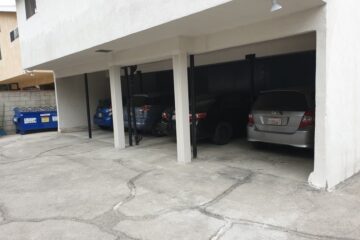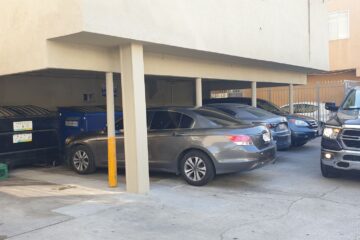


Soft Story Seismic Retrofit Building in Los Angeles.

Retrofit Cost of Soft Story Building in Los Angeles
The cost of seismic retrofitting a soft story building in Los Angeles can be a significant investment. The cost can vary depending on the
size and complexity of the building, as well as the extent of the retrofitting work required. ln general, the cost can range from tens of
thousands of dollars for a smaller building to several hundred thousand dollars for a larger and more complex structure.
Several factors can impact the cost of seismic retrofitting, such as the type of building, the number of stories, and the existing structural
condition of the building. The cost may also depend on the materials and techniques used for the retrofitting work, as well as the level of
customization required for each building.
The cost of retrofitting may also include permits, engineering and design fees, and inspections. In some cases, government grants or financing options may be available to help offset the cost of retrofitting.
Although the upfront cost of seismic retrofitting can seem daunting, it is important to consider the potential benefits in the long run
Retrofitting can help to protect the building and its occupants during an earthquake, prevents costly damage, and potentially lower insurance premiums. Moreover, seismic retrofitting is required by law in Los Angeles for certain types of buildings, so the cost of not retrofitting can result in hefty penalties. Building owners should consult with qualified engineers and contractors to determine the most cost-effective and appropriate retrofitting options for their buildings, while prioritizing safety and seismic resilience. In some cases, retrofitting may also provide opportunities to improve the building’s overall energy efficiency and reduce operational costs

Find the Right Contractor for your soft Story Building
Finding the right contractor for a soft story retrofit in Los Angeles is an important part of ensuring the safety and success of the project.
Here are some tips for selecting a qualified andbnreliable contractor for your soft story retrofit:
1. Research potential contractors
Start by conducting research on potential contractors who specialize in soft story retrofitting in Los Angeles. Look for contractors who have experience and expertise in retrofitting similar types of buildings.
3. Review portfolio and references
Ask to see the contractor's portfolio of completed projects and request references from previous clients. This can provide insight into the quality of their work and their level of customer satisfaction.
5. Communication and responsiveness
Choose a contractor who is responsive to your questions and concerns and communicates effectively throughout the project. This will help ensure that the project runs smoothly and an issues are addressed promptly.
2. Check credentials and licenses
Verify that the contractor has all the necessary licenses certifications, and insurance required to perform the work. This includes checking if they are licensed with the California Contractors State License Board (CSLB).
4. Request a detailed proposal
Ask potential contractors to provide a detailed proposal outlining the scope of work, timeline, and costs. This will help you compare proposals from different contractors and ensure that you are getting a fair and accurate estimate.
6. Consider their approach to safety
Choose a contractor who prioritizes safety and has a proven track record of implementing safe work practices. This is particularly important for soft story retrofitting projects, as they can involve working at heights and with heavy equipment
By taking the time to carefully research and select a qualified contractor for your soft story retrofit in Los Angeles, you can help ensure that
the project is completed safely, on time, and within budget.

Tenants Parking During Retrofit
Tenants’ need to park during the course of seismic retrofit is an important consideration that should be addressed by building owners and contractors before the retrofit work begins. During a seismic retrofit, parking spaces may need to be temporarily blocked off or eliminated to ensure the safety of tenants and workers This can cause inconvenience for tenants who rely on these parking spaces, but there are steps that can be taken to minimize the impact on their daily lives.
First, building owners and contractors should communicate with tenants well in advance of the retrofit work to inform them of any parking
restrictions or changes that will be implemented. This can help tenants plan ahead and make alternative arrangements if necessary.
Second, building owners and contractors should work together to find alternative parking solutions for tenants. This could include renting
nearby parking spaces or providing temporary parking permits for nearby parking lots or garages. It is important to ensure that the alternative parking options are safe, secure and easily accessible for tenants.
Third, building owners and contractors should prioritize the safety of tenants and workers during the retrofit work. This may require blocking off certain parking spaces or ever closing the entire parking area during certain phases of the work. While this may cause inconvenience for tenants, it is necessary to ensure that the retrofit work is completed safely and efficiently.
Finally, building owners and contractors should strive to complete the seismic retrofit work as quickly as possible to minimize the impact on tenants’ daily lives. This can be achieved through, effective planning and communication between all parties involved in the retrofit project.
In conclusion, tenants’ need to park during the course of seismic retrofit is an important consideration that should be addressed by building owners and contractors. By communicating effectively with tenants, finding alternative parking solutions, prioritizing safety, and completing the retrofit work efficiently, the impact on tenants can be minimized, and the retrofit project can be completed successfully.
Soft story seismic retrofit is a process of strengthening buildings in Los Angeles that have a weak first floor or “soft story”. These types of buildings, often found in multi-family residential and commercial properties built before 1980, are vulnerable to collapse during earthquakes. The retrofitting process typically involves the installation of steel frames and braces, which are designed to transfer seismic forces from the upper stories of the building down to the foundation. The frames and braces are installed on the first floor, which is often a garage or open space, and are connected to the building’s existing structure Before any work can begin, a structural engineer must evaluate the building and create a design that meets the requirements of the Los Angeles Department of Building and Safety.
The design must also meet California Building Code requirements for seismic safety.
Once the design is approved, the retrofitting process can begin. The first step is to prepare the building by removing any drywall or other finishes on the first floor. This allows access to the existing structure so that the steel frames and braces can be installed.
The steel frames and braces are then installed according to the engineer’s design. The frames are typically bolted to the foundation, and the
braces are connected to the frames and the upper floors of the building. After the soft story seismic retrofitting process is finished the building will undergo a final inspection by the Los Angeles Department of Building and Safety. If the building meets the necessary seismic safety requirements, a certificate of compliance (CofC) will be issued to certify its compliance.
Soft story seismic retrofitting is an important step in ensuring the safety of Los Angeles buildings and their occupants during earthquakes. By strengthening weak first floors buildings are better able to withstand seismic forces and reduce the risk of collapse